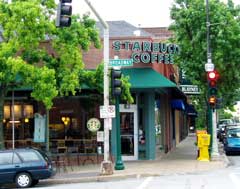Vol. V, No. 5, June 2005
- Editor's Corner
- Favorite foods: why ice cream rates high
- Foundations Entertainment University: July 19-21
- National Restaurant Association Show draws 70,000+
- The perils of selection bias in LBE development
- Fast-feeders raise the bar on coffee
- Where have the teenage workers gone?
- Waterpark resorts rapidly expanding
- Seconds count when serving that cup of Joe
- Our company's unique structure
- Death, taxes and Chuck E. Cheese's, aka the House of Terror
- uWink Media Bistro - a Chuck E. Cheese's for adults
- Chuck E. Cheese's $30-million remodel
- Allergy-free cooking for kids
- Current projects
Seconds count when serving that cup of Joe
 Quality
of coffee (see above story) isn't the only thing that matters to guests when it comes to serving up that cup of Joe. Just
as important is speed of service. As a follow-up to our April 2005 story,
Speed of Service, that took a look at speed of service at fast food drive-thrus, we thought it
would be informative to take at look at how important speed of service
was to Starbucks, the number one purveyor of premium prepared coffee.
Quality
of coffee (see above story) isn't the only thing that matters to guests when it comes to serving up that cup of Joe. Just
as important is speed of service. As a follow-up to our April 2005 story,
Speed of Service, that took a look at speed of service at fast food drive-thrus, we thought it
would be informative to take at look at how important speed of service
was to Starbucks, the number one purveyor of premium prepared coffee.
No different than the fast food feeders, Starbucks considers speed of service critical to success. "This is a game in seconds," says Silvia Peterson, Starbucks' director of store operations engineering. Peterson adds that she and 10 engineers are constantly asking themselves: "How can we shave time off this?"
Here are some of the measures Starbucks has taken to increase speed of service.
- Engineers noticed that the baristas who prepare drinks had to dig into the ice bins twice to scoop enough ice for Venti-size cold beverages, so they developed one-piece "volumetric ice scoops" that helped cut 14 seconds off the average preparation time.
- Starbucks has stopped requiring signatures for credit-card purchases under $25. Credit card purchases were taking on average 30 seconds to process. Eliminating signatures has reduced the time to 22 seconds.
- The company has added "floaters" to staffs who handle behind the scenes traffic such as running to the storage room for supplies or serving as back-up cashiers or baristas. Although floaters added to labor cost, they have resulted in a 20-second reduction to overall service time. (This is another example of why staff should not myopically be looked at as only a labor expense, but often as an investment -- see last month's story, The first thing we need to do is kill all the accountants.)
- Special espresso machines are being installed in all 9,000 outlets that with a push of a button grind coffee beans for espresso and then brew the beverage. The machines have shaved 24 seconds off the average time it takes to "pull an espresso shot," reducing the serving time from 60 seconds to 36 seconds.
Since 1999, service-time efforts like these have enabled Starbucks to increase average store revenues by about $200,000 to $940,000 annually.
In the world of time-pressed consumers who have lost their patience to
wait, seconds count. They count for guest satisfaction and they count
for maximizing throughput and revenues. The fast food feeders, coffee
outlets and convenience stores all understand the 'seconds count'
equation and are continually upping the ante of speedy service. It's
a never ending cycle. As consumer destinations such as these decrease
service time, consumer expectations are raised to expect speedier and
speedier service. Those destinations that don't look at how to engineer
their guest experiences to reduce service time will become slow moving
dinosaurs traveling down the road to extinction.
Vol. V, No. 5, June 2005
- Editor's Corner
- Favorite foods: why ice cream rates high
- Foundations Entertainment University: July 19-21
- National Restaurant Association Show draws 70,000+
- The perils of selection bias in LBE development
- Fast-feeders raise the bar on coffee
- Where have the teenage workers gone?
- Waterpark resorts rapidly expanding
- Seconds count when serving that cup of Joe
- Our company's unique structure
- Death, taxes and Chuck E. Cheese's, aka the House of Terror
- uWink Media Bistro - a Chuck E. Cheese's for adults
- Chuck E. Cheese's $30-million remodel
- Allergy-free cooking for kids
- Current projects


